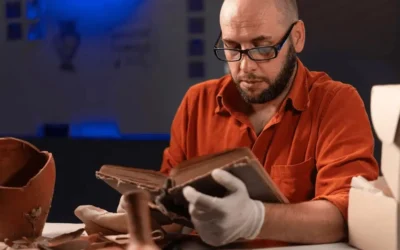Records and Archival Management within Organizations
Margot Note
Managing an organization’s current records is records management, and maintaining records of enduring value is archives management.
Organizing Current Records
Records managers identify and classify an organization’s records, monitor their use and storage, and facilitate access. Records policies outline the records management program’s authority, particularly legal mandates governing record creation and maintenance for administrative, legal, and fiscal purposes.
The lifecycle of an organization’s records, including creation, retention, and disposition instructions, is articulated in a records retention schedule. This document assigns responsibility for creating records and supports their disposition, or the length of time the organization retains records, whether temporary or permanent.
Employees complete business activities using current administrative, legal, and fiscal records. Records become inactive once they have fulfilled the original purpose of their creation; in many circumstances, the window of activity may be three years. Employees, guided by the records management department, retain their files for certain periods per their records retention schedule.
Managing Permanent Records
It is unnecessary, risky, and expensive to keep all records permanently. However, some records are inherent to an organization’s fiscal, legal, and intellectual viability, and the preservation of their heritage and an archives should permanently keep them.
The purpose of an archival repository is to preserve and make accessible records of enduring value. Many organizations establish archives programs to leverage their history as their most unique asset, which sets them apart from competitors. Archival materials directly result from an institution’s functions, offering a tribute to its core values, making accessible corporate memory, and preserving information to shape its future. Since every organization has a history, the benefits of a successful archival program are independent of size, age, prestige, and industry.
Types of Enduring Organizational Records
The archival records create its story. Materials created during business document an organization’s founding, growth, and change, define its structure, and display its accomplishments. Records come in all media: paper, digital files, audiovisual recordings, photographs, prints, and other formats used for recording and accessing information. Many organizations have historical documents, no matter their size or scope. They include a charter or articles of incorporation related to its founding, a constitution and bylaws regarding organizational purpose and structure, meeting minutes, financial records, bulletins, newsletters, programs, and publications, newspaper clippings, photographs, and sound and video recordings documenting organizational history. Archivists also include employee and payroll records, building plans, strategy documents, and other information in their repository.
Organizations also contend with processing and maintaining digital materials collections while preserving the records’ value, integrity, and context. Principles of archival practice consider the lifecycle of records, their organic nature, the hierarchy in records, and their description. They also consider the sanctity of evidence, such as the ability for records to provide insight into the activities and events leading to their creation. Archivists review the respect des fonds, or their grouping according to the nature of the institution that accumulated them, provenance, and original order.
Archival Benefits
An archival program returns its investment to the organization that hosts it. Like other resources provided by institutions, archival materials serve as assets to help organizations:
- Reduce operating costs
- Establish business continuity
- Centralize and improve the efficiency of information
- Support the legal and compliance departments
- Contribute to a sound risk management program
- Communicate stability in times of change
- Maximize the organization’s brand and reputation
- Provide marketing and public relations content
- Strengthen employee and client loyalty
- Preserve corporate memory and organizational heritage
- Conduct business intelligence services
- Track philanthropic activities over time
A well-organized archival program allows archivists to identify, save, and retrieve the necessary information while safely removing unnecessary material. Maintaining institutional knowledge through an archives program gives organizations a competitive edge.
Margot Note
Margot Note, archivist, consultant, and Lucidea Press author is a regular blogger, and popular webinar presenter for Lucidea, provider of ArchivEra, archival collections management software for today’s challenges and tomorrow’s opportunities. Read more of Margot’s posts here.
Never miss another post. Subscribe today!
Similar Posts
Texas Archive of the Moving Image: Interview with the Digital Archivist
I recently interviewed Grace Muñoz about her work at the Texas Archive of the Moving Image. Her work on improving the discoverability of the multimedia collection is fascinating.
How to Conduct Comprehensive Archival Surveys
Conducting a comprehensive archival survey is critical to successfully managing archival collections.
Remembering History, Moving Forward Together, with ArchivEra
The Catholic Diocese of Arlington’s Director of Archives selected ArchivEra to manage their collections of historical and cultural significance, and strike a balance between security and access.
Unveiling Archival Impact
The transformative power of storytelling depends upon the strategic choices that top archival performers make and the shift from being record-keepers to change agents.




Leave a Comment
Comments are reviewed and must adhere to our comments policy.
0 Comments